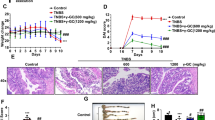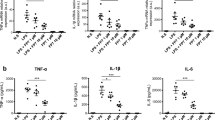Abstract
Objective
The elemental diet is one of the effective therapies for inflammatory bowel disease. However, the mechanism remains unclear, and there have never been reports about the inhibitory effects of amino acids in human monocytes/macrophages. We investigated the inhibitory effects of amino acids on cytokine production or expression of adhesion molecules that are involved in inflammatory diseases, in human monocytes/macrophages.
Methods
We examined the inhibitory effects of cysteine, histidine or glycine on the induction of nuclear factor-κB (NF-κB) activation, expression of intracellular adhesion molecule-1 (ICAM-1, CD54) and production of interleukin-8 (IL-8) in THP-1 cells, a human monocytic leukemia cell line, and peripheral blood mononuclear cells (PBMCs) stimulated with tumor necrosis factor-α (TNF-α).
Results
Cysteine, histidine and glycine significantly reduced the activation of NF-κB in THP-1 cells stimulated with TNF-α. In addition, cysteine and histidine significantly inhibited the expression of ICAM-1 and production of IL-8 in THP-1 cells and PBMCs.
Conclusions
Our results suggest that cysteine and histidine exhibit anti-inflammatory effects in THP-1 cells, and may be responsible for the efficacy of treatment in inflammatory bowel diseases.





Similar content being viewed by others
References
Xavier RJ, Podolsky DK. Unravelling the pathogenesis of inflammatory bowel disease. Nature. 2007;448:427–34.
Himmel ME, Hardenberg G, Piccirillo CA, Steiner TS, Levings MK. The role of T-regulatory cells and Toll-like receptors in the pathogenesis of human inflammatory bowel disease. Immunology. 2008;125:145–53.
Strober W, Fuss I, Mannon P. The fundamental basis of inflammatory bowel disease. J Clin Invest. 2007;117:514–21.
Zhou L, Braat H, Faber KN, Dijkstra G, Peppelenbosch MP. Monocytes and their pathophysiological role in Crohn’s disease. Cell Mol Life Sci. 2009;66:192–202.
Brown SJ, Mayer L. The immune response in inflammatory bowel disease. Am J Gastroenterol. 2007;102:2058–69.
Sanchez-Munoz F, Dominguez-Lopez A, Yamamoto-Furusho JK. Role of cytokines in inflammatory bowel disease. World J Gastroenterol. 2008;14:4280–8.
Baumgart DC, Carding SR. Inflammatory bowel disease: cause and immunobiology. Lancet. 2007;369:1627–40.
Rutgeerts P, D’Haens G, Targan S, Vasiliauskas E, Hanauer SB, Present DH, Mayer L, Van Hogezand RA, Braakman T, DeWoody KL, Scaible TF, Van Deventer SJ. Efficiency and safety of retreatment with anti-tumor necrosis factor antibody (infliximab) to maintain remission in Crohn’s disease. Gastroenterology. 1999;117:761–9.
D’haens G, Van Deventer S, Van Hogezand R, Chalmers D, Kothe C, Baert F, Braakman T, Schaible T, Geboes K, Rutgeerts P. Endoscopic and histological healing with infliximab anti-tumor necrosis factor antibodies in Crohn’s disease: a European multicenter trial. Gastroenterology. 1999;116:1029–34.
Present DH, Rutgeerts P, Targan S, Hanauer SB, Mayer L, van Hogezand RA, Podolsky DK, Sands BE, Braakman T, DeWoody KL, Schaible TF, van Deventer SJ. Infliximab for treatment of fistulas in patients with Crohn’s disease. N Engl J Med. 1999;340:1398–405.
Sandborn WJ, Feagan BG, Hanauer SB, Present DH, Sutherland LR, Kamm MA, Wolf DC, Baker JP, Hawkey C, Archambault A, Bernstein CN, Novak C, Heath PK, Targan SR. An engineered human antibody to TNF (CDP571) for active Crohn’s disease: a randomized double-blind placebo-controlled trial. Gastroenterology. 2001;120:1330–8.
Collart MA, Baeuerle P, Vassalli P. Regulation of tumor necrosis factor alpha transcription in macrophages: Involvement of four κB-like motifs and of constitutive and inducible forms of NF-κB. Mol Cell Biol. 1990;10:1498–506.
Libermann TA, Baltimore D. Activation interleukin-6 gene expression through the NF-κB transcription factor. Mol Cell Biol. 1990;10:2327–34.
Chen CC, Rosenbloom CL, Anderson DC, Manning AM. Selective inhibition of E-selectin, vascular cell adhesion molecule-1, and intracellular adhesion molecule-1 expression by inhibitors of IκB-α phosphorylation. J Immunol. 1995;155:3538–45.
Matsusaka T, Fujikawa K, Nishio Y, Mukaida N, Matsushima K, Kishimoto T, Akira S. Transcription factors NF-IL6 and NK-κB synergistically activate transcription of the inflammatory cytokines, interleukin 6 and interleukin 8. Proc Natl Acad Sci USA. 1993;90:10193–7.
Kunsch C, Lang RK, Rosen CA, Shannon MF. Synergistic transcriptional activation of the IL-8 gene by NF-κB p65 (RelA) and NF-IL-6. J Immunol. 1994;153:153–64.
Mukaida N, Mahe Y, Matsushima K. Cooperative interaction of nuclear factor-κB- and cis-regulatory enhancer binding protein-like factor binding elements in activating the interleukin-8 gene by pro-inflammatory cytokines. J Biol Chem. 1990;265:21128–33.
Ueda A, Ishigatsubo Y, Okubo T, Yoshimura T. Transcriptional regulation of the human monocyte chemoattractant protein-1 gene. J Biol Chem. 1997;272:31092–9.
Faffe DS, Whitehead T, Moore PE, Baraldo S, Flynt L, Bourgeois K, Panettieri RA, Shore SA. IL-13 and IL-4 promote TARC release in human airway smooth muscle cells: role for IL-4 genotype. Am J Physiol Lung Cell Mol Physiol. 2003;285:907–14.
Sekiya T, Tsunemi Y, Miyamasu M, Ohta K, Morita A, Saeki H, Matsushima K, Yoshie O, Tsuchiya N, Yamaguchi M, Yamamoto K, Tamaki K, Hirai K. Variations in the human TH2-specific chemokine TARC gene. Immunogenetics. 2003;54:742–5.
Tsune I, Ikejima K, Hirose M, Yoshikawa M, Enomoto N, Takei Y, Sato N. Dietary glycine prevents chemical-induced experimental colitis in the rat. Gastroenterology. 2003;125:775–85.
Andou A, Hisamatsu T, Okamoto S, Chinen H, Kamada N, Kobayashi T, Hashimoto M, Okutsu T, Shimbo K, Takeda T, Matsumoto H, Sato A, Ohtsu H, Suzuki M, Hibi T. Dietary histidine ameliorates murine colitis by inhibition of proinflammatory cytokine production from macrophage. Gastroenterology. 2009;136:564–74.
Son DO, Satsu H, Shimizu M. Histidine inhibits oxidative stress- and TNF-α-induced interleukin-8 secretion in intestinal epithelial cells. FEBS Lett. 2005;579:4671–7.
Wheeler MD, Thurman R. Production of superoxide and TNF-α from alveolar macrophages is blunted by glycine. Am J Physiol. 1999;277:L952–9.
Stachlewitz RF, Li X, Smith S, Bunzendahl H, Graves LM, Thurman RG. Glycine inhibits growth of T lymphocytes by an IL-2-independent mechanism. J Immunol. 2000;164:176–82.
Li X, Bradford BU, Wheeler MD, Stimpson SA, Pink HM, Brodie TA, Schwab JH, Thurman RG. Dietary glycine prevents peptidoglycan-polysaccharide-induced reactive arthritis in the rats: role for glycine-gated chloride channel. Infect Immun. 2001;69:5883–91.
Wheeler MD, Rose ML, Yamashima S, Enomoto N, Seabra V, Madren J, Therman RG. Dietary glycine blunts lung inflammatory cell influx following acute endotoxin. Am J Physiol Lung Cell Mol Physiol. 2000;279:L390–8.
Liboni KC, Li N, Scumpia PO, Neu J. Glutamine modulates LPS-induced IL-8 production through IκB/NF-κB in fetal and adult intestinal epithelium. J Nutr. 2005;135:245–51.
Yamamoto T, Nakahigashi M, Umegae S. Impact of elemental diet on mucosal inflammation in patients with active Crohn’s disease. Cytokine production and endoscopic and histological findings. Inflamm Bowel Dis. 2005;11:580–8.
Kim CJ, Kovacs-Nolan J, Yang C, Archbold T, Fan MZ, Mine Y. l-cysteine supplementation attenuates local inflammation and restores gut homeostasis in porcine model of colitis. Biochim Biophys Acta. 2009;1790:1161–9.
Auwerx J. The human leukemia cell line, THP-1: a multifaceted model for the study of monocyte-macrophage differetiation. Experientia. 1991;47:22–31.
Renard P, Ernest I, Houbion A, Art M, Le Calvez H, Raes M, Remacle J. Development of a sensitive multi-well colorimetric assay for active NF-κB. Nucleic Acids Res. 2001;29:e21.
Ichiyama T, Nishikawa M, Yoshitomi T, Hasegawa S, Matsubara T, Hayashi T, Furukawa S. Clarithromycin inhibits NF-kappaB activation in human peripheral blood mononuclear cells and pulmonary epithelial cells. Antimicrob Agents Chemother. 2001;45:44–7.
Yoneshima Y, Ichiyama T, Ayukawa H, Matsubara T, Furukawa S. Fosfomycin inhibits NF-kappaB activation in U-937 and Jurkat cells. Int J Antimicrob Agents. 2003;21:589–92.
Umeda M, Ichiyama T, Hasegawa S, Kaneko M, Matsubara T, Furukawa S. Theophylline inhibits NF-kappaB activation in human peripheral blood mononuclear cells. Int Arch Allergy Immunol. 2002;128:130–5.
Ichiyama T, Hasegawa S, Matsubara T, Hayashi T, Furukawa S. Theophylline inhibits NF-κB activation and IκBα degradation in human pulmonary epithelial cells. Naunyn-Schmiedeberg’s Arch Pharmacol. 2001;364:558–61.
Ichiyama T, Hasegawa S, Umeda M, Terai K, Matsubara T, Furukawa S. Pranlukast inhibits NF-kappa B activation in human monocytes/macrophages and T cells. Clin Exp Allergy. 2003;33:802–7.
Ichiyama T, Ueno Y, Hasegawa M, Niimi A, Matsubara T, Furukawa S. Intravenous immunoglobulin inhibits NF-κB activation and affects Fcγ receptor expression in monocytes/macrophages. Naunyn-Schmiederberg’s Arch Pharmacol. 2004;369:428–33.
Ichiyama T, Ueno Y, Isumi H, Niimi A, Matsubara T, Furukawa S. An immunoglobulin agent (IVIG) inhibits NF-κB activation in cultured endothelial cells of coronary arteries in vitro. Inflamm Res. 2004;53:253–6.
Kim CJ, Kovacs-Nolan JA, Yang C, Archbold T, Fan MZ, Mine Y. l-Tryptophan exhibits therapeutic function in a porcine model of dextran sodium sulfate (DSS)-induced colitis. J Nutr Biochem. 2010;21:468–75.
Wheeler MD, Ikejema K, Enomoto N, Stacklewitz RF, Seabra V, Zhong Z, Yin M, Schemmer P, Rose ML, Rusyn I, Bradford B, Thurman RG. Glycine: a new anti-inflammatory immunonutrient. Cell Mol Life Sci. 1999;56:843–56.
Ukeda H, Hasegawa Y, Harada Y, Sawamura M. Effect of carnosine and related compounds on the inactivation of human Cu, Zn-superoxide dismutase by modification of fructose and glycolaldehyde. Biosci Biotechnol Biochem. 2002;66:36–43.
Guiotto A, Calderan A, Ruzza P, Borin G. Carnosine and carnosine-related antioxidants: a review. Curr Med Chem. 2005;12:2293–315.
Yan SL, Wu ST, Yin MC, Chen HT, Chen HC. Protective effects from carnosine and histidine on acetaminophen-induced liver injury. J Food Sci. 2009;74:H259–65.
O’Hara AM, Bhattacharyya A, Bai J, Mifflin RC, Ernst PB, Mitra S, Crowe SE. Tumor necrosis factor (TNF)-alpha-induced IL-8 expression in gastric epithelial cells: role of reactive oxygen species and AP endonuclease-1/redox factor (Ref)-1. Cytokine. 2009;46:359–69.
Acknowledgments
This study was supported in part by Morinaga Hoshi-kai to S. Hasegawa. All authors have no conflicts of interest.
Author information
Authors and Affiliations
Corresponding author
Additional information
Responsible Editor: Makoto Katori.
Rights and permissions
About this article
Cite this article
Hasegawa, S., Ichiyama, T., Sonaka, I. et al. Amino acids exhibit anti-inflammatory effects in human monocytic leukemia cell line, THP-1 cells. Inflamm. Res. 60, 1013–1019 (2011). https://doi.org/10.1007/s00011-011-0362-1
Received:
Revised:
Accepted:
Published:
Issue Date:
DOI: https://doi.org/10.1007/s00011-011-0362-1




